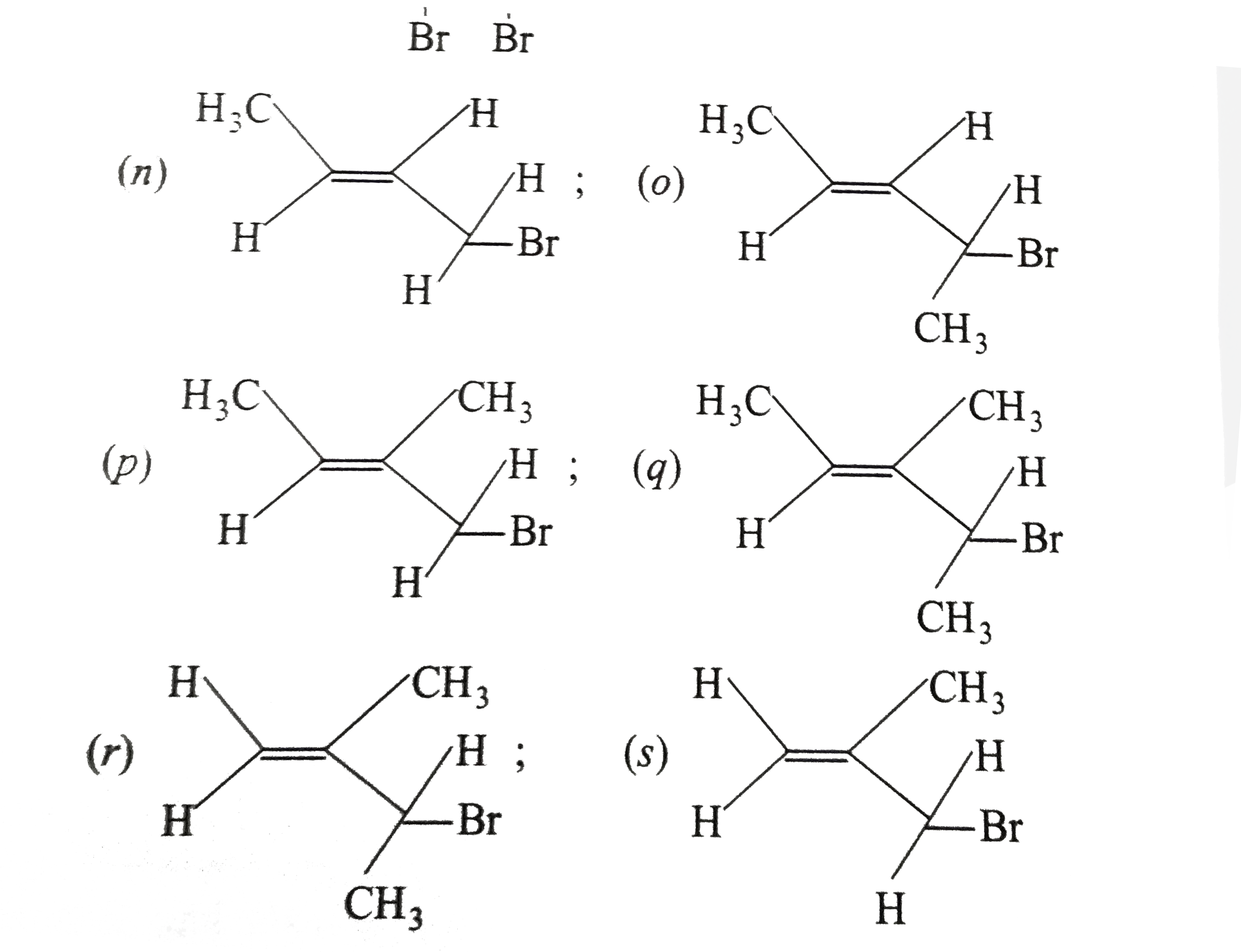CH3−C≡C−CH3(1)H2/Pt−−−−−−→(2)Br2X
(d)-2, 3-Dibromobutane
(l)-2, 3-Dibromobutane
(dl)-2, 3-Dibromobutane
meso-2, 3-Dibromobutane
The correct Answer is:C
To solve the given reaction step by step, let's break it down into two main parts: hydrogenation and bromination.
Step 1: Identify the Starting Compound
The starting compound is CH₃-C≡C-CH₃, which is 2-butyne. It has a triple bond between the second and third carbon atoms.
Step 2: Hydrogenation
The first step is hydrogenation, which is the addition of hydrogen (H₂) to the triple bond in the presence of a catalyst (Pt). This process converts the triple bond into a double bond, resulting in the formation of an alkene.
- The reaction can be represented as:
CH3−C≡C−CH3+H2Pt−→CH3−C=C−CH3
- The product formed is 2-butene (specifically, it can be either cis or trans depending on the addition of hydrogen).
Step 3: Bromination
The next step is bromination, which involves the addition of bromine (Br₂) to the double bond formed in the previous step. This is an electrophilic addition reaction.
- The reaction can be represented as:
CH3−C=C−CH3+Br2→Br−C−C−Br
- Since bromine adds across the double bond, we can expect that the bromine atoms will add to opposite sides of the double bond, leading to the formation of a racemic mixture of 2,3-dibromobutane.
Step 4: Final Product
The final product of the reaction is a racemic mixture of 2,3-dibromobutane, which means that both enantiomers (D and L forms) are produced.
Summary of the Reaction
The overall reaction can be summarized as:
CH3−C≡C−CH3H2/Pt−−−→CH3−C=C−CH3Br2−−→2,3-Dibromobutane (racemic mixture)
The starting compound is CH₃-C≡C-CH₃, which is 2-butyne. It has a triple bond between the second and third carbon atoms.
The first step is hydrogenation, which is the addition of hydrogen (H₂) to the triple bond in the presence of a catalyst (Pt). This process converts the triple bond into a double bond, resulting in the formation of an alkene.
CH3−C≡C−CH3+H2Pt−→CH3−C=C−CH3
The next step is bromination, which involves the addition of bromine (Br₂) to the double bond formed in the previous step. This is an electrophilic addition reaction.
CH3−C=C−CH3+Br2→Br−C−C−Br
The final product of the reaction is a racemic mixture of 2,3-dibromobutane, which means that both enantiomers (D and L forms) are produced.
The overall reaction can be summarized as:
CH3−C≡C−CH3H2/Pt−−−→CH3−C=C−CH3Br2−−→2,3-Dibromobutane (racemic mixture)
Topper's Solved these Questions
- HYDROCARBON BOOK - MOTIONCHAPTER - HYDROCARBON EXERCISE - Exercise - 4 (Level-I)
34 Videos
- HYDROCARBON BOOK - MOTIONCHAPTER - HYDROCARBON EXERCISE - Exercise - 4 (Level-II)
15 Videos
- HYDROCARBON BOOK - MOTIONCHAPTER - HYDROCARBON EXERCISE - Exercise - 2 (Level-I)
29 Videos
- GRIGNARD REAGENTBOOK - MOTIONCHAPTER - GRIGNARD REAGENTEXERCISE - EXERCISE-2
16 Videos
- IONIC EQUILIBRUIMBOOK - MOTIONCHAPTER - IONIC EQUILIBRUIMEXERCISE - Exercise -4 (Level -II)
14 Videos
Similar Questions
Knowledge Check
CH3−C≡C−CH3H2−−−−−−→Pd−BaSO4
(A) Br2−−→CCl4(B)AMesoBRacemic mixtureCDiastereomersDAll(CH3)2C=CH2Br2−−→H2O
The major product of the reaction isA(CH3)2C(OH)CH2BrB(CH3)2C(Br)CH2OHC(CH3)2C(OH)CH2OHD(CH3)2C(Br)CH2BrThe major product of the following reaction is :
C6H5CH2−CH3∣C∣Br=CH2−CH3C2H5ONa−−−−−→C2H5OHAC6H5CH=C∣CH3−CH2CH3BC6H5CH2−C∣Ch3=CHCH3CC6H5CH2CH3∣C∣OC2H5−CH2CH3DC6H5CH2−C∣CH2CH3=CH2
Given the IUPAC names of the following compounds:
(i) CH3CH2CH2CH3C∣∣C2H5CH2−CH3∣C=CH2
(ii) CH3−CH3CH−C≡CH
(iii) C6H5−CH=CH−CH2Cl
CH3CH−CH−CH2Cl
(iv) CH3CH=CH−CH2Br
v CH2=CH−Cl∣C−CH=CH2
vi CH2=CH−CH2CH3C∣H−C∣Cl=CH2
vii. (CH3)3C−CH=CH2
View SolutionGive the IUPAC names of the following compounds:
(a)(CH3)3C−CI (b)CH3−C∣C2H5H−CH2CI
(c)H2c=CH−C∣C2H5H−C∣CI=CH2
(d)CH−C2H5∣C∣CI−CH2−C2H5∣C∣Br−CH3
(e)(CH3)3C−CH2−CH2CI
(f)(CH3)3C−C∣CH3H−C∣IH−CH2CH3
(g)CH3−C2H5∣C∣F−CH2−C2H5∣C∣CI−CH3
(h)HC≡C−CH2−CH=CHCI
(i)BrCH2−CH2−CH2−CH2CI
(j)CH3−C≡C−C∣CIH−CH3
(k)(C2H5)3C−CI
(l)CH3CH2−CH3∣C∣Br−C∣BrHCH2CI (m)HC≡C−CH2Br

View SolutionThe major product of the following reaction is:
C6H5CH2−CH3∣C∣Br−CH2−CH3C2H5Na−−−−→C2H5OH
View SolutionWhich of the following compounds will give racemic mixture on nucleophilic substitution by OH− ion?
(I) CH3−C∣C2H5H−Br
(II) CH3−Br∣C∣C2H5−CH3
(III) CH3−C∣C2H5H−CH2Br
View SolutionCH3−C∣BrH−CH2−O∣∣C−CH3N2H4,ӨOH−−−−−→Δ product :
View Solution
